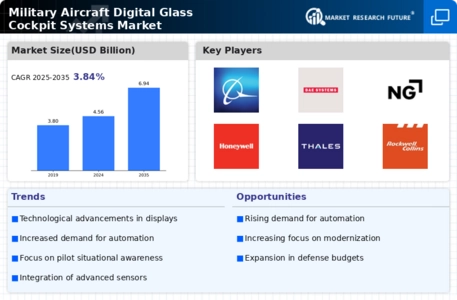Market Trends
Key Emerging Trends in the Military Aircraft Digital Glass Cockpit Systems Market
The Military Aircraft Digital Glass Cockpit Systems market is witnessing significant trends that reflect the ongoing technological advancements in military aviation. One prominent trend is the widespread adoption of digital glass cockpit systems in military aircraft. These advanced cockpit configurations replace traditional analog gauges and instruments with high-resolution digital displays, offering enhanced situational awareness, improved data presentation, and streamlined cockpit management. The transition to digital glass cockpit systems is driven by the need for modernization and the desire to equip military aircraft with cutting-edge avionics, ultimately enhancing the operational capabilities of these platforms.
Integration of Multi-Function Displays (MFDs) is another key trend in military aircraft digital glass cockpit systems. MFDs consolidate multiple functions and information onto a single display unit, providing pilots with comprehensive data at their fingertips. This trend allows for more efficient and intuitive control of various systems, reducing pilot workload and enhancing overall mission effectiveness. The versatility of MFDs enables customization for different mission profiles, making military aircraft more adaptable to diverse operational requirements.
Augmented Reality (AR) and Head-Up Display (HUD) technologies are making significant inroads into military aircraft cockpit design. AR systems overlay critical flight data and information directly onto the pilot's line of sight, enhancing situational awareness and reducing the need to look down at traditional instruments. HUDs project key information onto a transparent screen in the pilot's field of view, allowing them to keep their eyes on the external environment while receiving crucial data. These technologies contribute to improved pilot performance, especially in high-stakes and dynamic operational scenarios.
Enhanced connectivity features are emerging as a notable trend in military aircraft digital glass cockpit systems. These systems are increasingly equipped with advanced communication interfaces, facilitating seamless data exchange between the aircraft, ground control, and other airborne platforms. Enhanced connectivity supports real-time information sharing, mission coordination, and collaborative decision-making, contributing to a more network-centric approach in military operations. This trend aligns with the broader concept of integrated and networked warfare, where information sharing and communication capabilities play a central role in mission success.
Cybersecurity considerations are becoming increasingly important in the development of military aircraft digital glass cockpit systems. As these systems rely heavily on digital technologies and connectivity, ensuring the integrity and security of the onboard avionics is paramount. The rising threat of cyber attacks prompts military aircraft manufacturers to incorporate robust cybersecurity measures into their cockpit designs. This trend reflects the growing recognition of the vulnerabilities associated with digital systems in military aviation and the need to safeguard critical defense assets from potential cyber threats.
Furthermore, there is a noticeable trend toward the use of open architecture in military aircraft digital glass cockpit systems. Open architecture designs facilitate interoperability and allow for easier integration of third-party systems and components. This trend enables military organizations to adapt and upgrade their aircraft systems more flexibly, accommodating advancements in technology and addressing evolving mission requirements. Open architecture principles contribute to the longevity and scalability of digital glass cockpit systems, ensuring that military aircraft remain technologically relevant over extended operational lifetimes.

















Leave a Comment